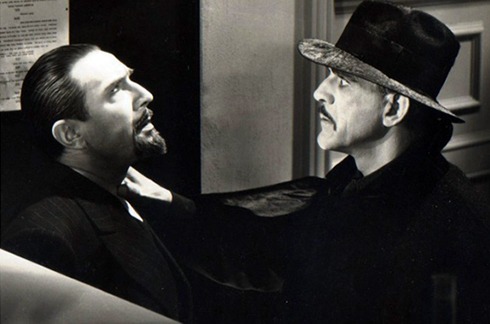The Invisible Ray (1936)
“I believe that this city is at the mercy of a madman whose body is an engine of destruction.” – Dr Felix Benet


As far as I can recall, I’ve never used the term “pot boiler” to describe a film in any of the 20 plus years I’ve been writing about films here and there. But I really can’t think of a better word to describe The Invisible Ray. It’s a film with an element of science fiction to be sure. But it also has a healthy spoonful of horror. The problem is, it doesn’t really fully fit into either camp. But as Shocktober is all about the Universal movies this year, and Karloff and Lugosi are the stars – it would surely be churlish not to include it.
1936 was a transitional year for Universal Pictures. As we’ve seen, they had made their name in the industry with their horror movie specialisation, apart from the horrors, they occasionally made a more prestige film to boost their respectability and their bank balance. But things were about to change. Universal in the thirties was not a multi-billion-dollar conglomerate, it was a family business, founded and run by the Laemmle family and employed as many family members, cousins and hangers on as they could. More than necessary. They also gambled on major box office bonanzas that never paid off as much as they hoped. The company was in trouble and the family were about to lose the family business. So, 1936 saw the last of Universal’s horror run and saw only two genre films released, this and Dracula’s Daughter which I’ll be covering tomorrow. No new Universal horror films would be released until 1939. But more of that in days to come. On with the show
The film starts with a grim warning…
“Every scientific fact accepted today once burned as a fantastic fire in the mind of someone called mad.
Who are we on the youngest and smallest of planets to say that the INVISIBLE RAY is impossible to science?
That which you are now to see is a theory whispered in the cloisters of science. Tomorrow these theories may startle the universe as a fact.”
Wow – heavy. Okay, we’re now 74 years on and science fact has yet to embrace The Invisible Ray as a documentary, so there we go. Speaking of the invisible ray, it actually plays only a small role in the film. Just a thing to get the plot moving along. It’s a McGuffin as Alfred Hitchcock would say.
In a castle in the Carpathians, Janos Rukh (Boris Karloff) lives with his wife Diana (Frances Drake) and elderly mother who has been blinded in an earlier experiment. The mother is played by Violet Kemble Cooper and immediately, there’s a problem. She looks more like Karloff’s sister than his mother, due to the fact that the actress was in reality only a few months older than he was.
They’re awaiting a party of scientists who are on their way to observe a scientific demonstration by Rukh, who feels he’s been marginalised by the scientific community for his unorthodox work.
On arrival, the party, which includes Dr Felix Benet (Bela Lugosi) is shown to Rukh’s lab, which was reused that same year for Dracula’s Daughter and was seen as the laboratory of Ming the Merciless in the Flash Gordon serial. Rukh has developed (naturally) an invisible ray, which he can shoot out of a massive telescope then (somehow) when the ray has reached the Andromeda galaxy in a few seconds (just don’t ask), Rukh can (somehow) look back along the ray and see the Earth as it was “thousands of millions of years ago” – his words, not mine, and see a meteorite hit the (curiously totally cloudless) Earth somewhere in Africa.
Suitably impressed they all decide to head off to Africa to find the meteorite.
Rukh finds the meteorite and this I where the everything goes horribly wrong – he terrorises his native bearers by melting a boulder with a ray gun that projects the power of the meteorite and threatens to use it on them.
Rukh soon himself becomes contaminated by the Radium X, the radioactive material emitted by the rock, and discovers his touch is lethal – not that Rukh can really sneak up on you in the dark, his hands and face have become phosphorescent. But luckily, Dr Benet can help with an antidote. Much like the poor Werewolf of London, it’s not a cure and is only temporary. He’s going to need that serum for the rest of his life.
But there’s another problem. The Radium X is making Rukh insane. To the point that he doesn’t really want to share his discovery (even though Benet uses it to cure blindness and generally benefit humanity) and feels betrayed. He even fakes his own death so Diana can marry her young suitor Ronald (Frank Lawton). But then, he decides he’s going to kill them all and follows them to Paris where they’re attending a scientific conference. Staying opposite a grand cathedral (the leftover set from the studio’s silent version of The Hunchback of Notre Dame) he melts one of six statues for every person who betrayed him that he kills. These include the newly remarried Diana and her husband.
Benet knows who’s doing the killing, though – having examined the first victim and discovered the image of Rukh’s radioactive face imprinted on the victim’s eye (don’t even…) and sets a trap for Rukh before he too falls victim to the glowy touch of death.
In the end, it’s Ma Rukh who saves the day for the remaining cast members by confronting her son and basically telling him he’s a naughty boy. Rukh, in shame, dives out of a window but spontaneously ignites before hitting the ground.
Overall, it’s a fast paced, entertaining film – but not really Karloff and Lugosi’s best screen teaming.
